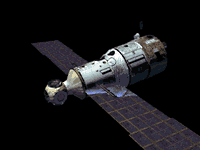Mir Core Module
Part of the Mir Space Station program
 The Mir core module is the backbone of the Mir space station. Derived from the prior Salyut 6 and 7 space stations, it acts as the principal space station control element and contains the main computers, communications equipment, kitchen and hygiene facilities, and primary living quarters. The module provides 90 cubic meters of habitable volume. The core module includes six docking ports used as permanent attachment points for the other station modules and for temporary docking of manned and unmanned resupply ships. Although the core module's main propulsion system has not been operational since the arrival of Kvant 1, the core acts as the principal propellant storage unit and assists in controlling the attitude of the entire space station. The core is divided into four compartments, designated as the working, transfer, intermediate and assembly compartments. All but the assembly compartment are pressurized. A small airlock is also available for experiments or for the release of small satellites or refuse.
The Mir core module is the backbone of the Mir space station. Derived from the prior Salyut 6 and 7 space stations, it acts as the principal space station control element and contains the main computers, communications equipment, kitchen and hygiene facilities, and primary living quarters. The module provides 90 cubic meters of habitable volume. The core module includes six docking ports used as permanent attachment points for the other station modules and for temporary docking of manned and unmanned resupply ships. Although the core module's main propulsion system has not been operational since the arrival of Kvant 1, the core acts as the principal propellant storage unit and assists in controlling the attitude of the entire space station. The core is divided into four compartments, designated as the working, transfer, intermediate and assembly compartments. All but the assembly compartment are pressurized. A small airlock is also available for experiments or for the release of small satellites or refuse.
Working Compartment
The working compartment is the main habitable volume on Mir and consists of two concentric cylinders connected by a tapered conical section. The interior of the working compartment is divided into an operations zone and a living area. The operations zone occupies the smaller diameter section and is the control area for the entire Mir complex. Monitoring and commanding of the core systems, scientific equipment and mechanisms are carried out in this area. The living area of the working compartment provides the necessities for long-term manned missions and contains a galley area, individual crew cabins, hygiene facilities and trash storage. Medical monitoring equipment and a bicycle ergometer are located in the conical portion of the working compartment.
The Mir Complex crew prefers a spatial orientation of floor and ceiling with the sides arranged in a bottom-to-top orientation, despite the formal irrelevance of the terms in microgravity. The floor of the operations area is covered with dark green carpet, the walls are a light green and the ceiling white with florescent lamps. The arrangement of equipment and the interior finish of the working compartment are designed to reinforce this bottom-to-top orientation. The living area uses the same spatial orientation concepts, but soft pastel colors are used to imply a home-like atmosphere.
Transfer Compartment
The spherical transfer compartment is located at the fore end of the working compartment. It provides radial docking ports, spaced at 90 degree increments, for 4 of the station's added modules with a 5th additional axial docking port for visiting transport craft. Access to the additional station modules is provided through the transfer compartment.
Intermediate Compartment
The intermediate compartment is a 2 meter diameter pressurized tunnel that connects the working module to the aft docking port. The tunnel is located in the center of the non-pressurized assembly compartment. The aft docking port was used for visiting transport vehicles until permanently occupied by the Kvant 1 module.
Assembly Compartment
Main engine and fuel tanks are located in the non-pressurized assembly compartment. This annular space contains the main engine and fuel tanks. Externally, this assembly supports the station's satellite relay antenna, docking radar antennas, lights and optical sensors.
Spacecraft
Power to the core module was initially provided by 2 38 sq. meter arrays providing 9 kW. A 3rd array was added to the core in 1987 to bring total power to 10.1 kW. Additional power from visiting Progress-M and Soyuz-TM vehicles and other station modules can be added to the station's total supply. The core contains 12 NiCd batteries for power storage. The core is also equipped with 32 137 N attitude control thrusters and 2 2.9 kN thrusters for orbit maintenance (useless while Kvant 1 is attached). The propulsion system is a pressure fed UDMH/NTO system. Life support system maintains the station's environment at 18-28 deg. C and 20-70 percent humidity. An electrolytic system is used to recycle station atmosphere with a backup chemical scrubbing system. Station pointing can be controlled to within 15 arcmin. 2 primary CPUs provide most station control functions. Star sensors, IR Earth horizon sensors, sun sensors, magnetometers, gyros, accelerometers are used for attitude determination. Communication with the ground is via 11-14 GHz links through geosynchronous relay satellites.
| Country of Origin | USSR |
| Size | 13.13 meters long x 4.15 meters dia. |
Launch Facts
| Name | Int'l Desig. | Date | Site | Vehicle | Orbit | Mass(kg) |
| Notes | ||||||
| Mir Core Module | 1986-017A | 2/19/86 | Tyuratam | SL-13 | LEO | 20100 |
| Space station core module | ||||||
Information in The Mission and Spacecraft Library is provided without warranty or guarantee. USE AT YOUR OWN RISK.